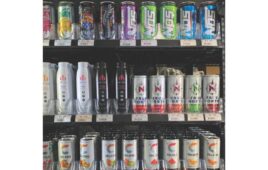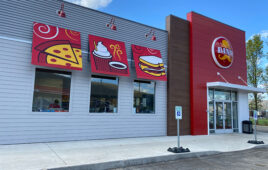Food offerings that once were considered exotic are becoming everyday cuisines in many convenience stores.
By Pat Pape, Contributing Editor

A few years ago, dining on Colombian, Korean or Szechuan fare was a novel experience for most Americans.
But thanks to growing Hispanic and Asian communities in the U.S. ethnic foods are now widely available, particularly in the restaurants and grocery stores of most metropolitan areas.
Diners appear to be seeking new, different and tasty offerings. When the National Restaurant Association (NRA) surveyed almost 1,600 professional chefs last year regarding the most current restaurant trends, the chefs listed African flavors, authentic ethnic cuisine, ethnic condiments/spices and Middle Eastern tastes.
Mintel, the global consumer research organization, recently reported that households with children are more likely to consume, not only more ethnic cuisines, but a greater variety of international foods. That habit will impact the attitudes and expectations of diners in the future, making flavors from around the globe even more recognized and expected.
According to Datassential, which offers analysis and concept testing to the food industry, members of Gen Z, the multicultural generation born in 1997 or later, don’t even use the term ethnic food. Today’s youth are so familiar with ethnic offerings that they simply eat tacos or ramen as opposed to labeling their meals “Mexican” or “Japanese.”
LAREDO TACO
As of July 1, 2015, there were more than 56 million Hispanic people in the U.S., making residents of Hispanic origin the nation’s largest ethnic minority at 17.6% of the total population. Along with the population growth has come an enthusiastic demand for Mexican cuisine and its domestic adaptations, such as Tex-Mex.
Stripes, a Corpus Christi, Texas-based c-store chain with more than 400 locations, developed its Laredo Taco line of authentic Hispanic offerings for its outlets in Texas, New Mexico and Oklahoma. After the chain was purchased by Sunoco Inc. in 2014, the new owners decided to expand the successful Mexican food program to its existing APlus convenience locations, many of which are located beyond the Southwestern U.S.
“The first Laredo Taco Co. opened [outside the Southwest] in January in Greensburg, Pa.,” said Jeff Shields, communications manager for Sunoco Logistics. “There are now 11—six in Tennessee and five in Philadelphia. We expect to have 20 by year’s end between Pennsylvania, Tennessee and Northern Virginia.”
At these new locations, the menu is nearly the same as in Southwestern stores, which include a dozen different breakfast taco selections, a dozen lunch varieties, quesadillas and Mexican food plates with enchiladas or meat, rice and beans. Customers can also add a of variety of sauces and pico de gallo that are made in the store each day from fresh vegetables.
“Laredo Taco’s appeal in the Northeast should be what made it successful in the Rio Grande Valley—fresh, hand-made meals prepared in front of you,” said Shields. “With offerings, such as tortillas, made fresh daily in the store, coupled with salsas made fresh every day and ingredients cooked from scratch, Laredo Taco offers something its competitors can’t match.”
Already, customer feedback has been positive, and “we will continue to expand the brand’s market reach both in the Southwest and the Eastern U.S.,” he said.
HOME COOKING
Daily, about 46,000 vehicles traverse Highway 550 in Bernalillo, N.M., passing between two Warrior convenience stores located directly across the street from each other. Owned by Pueblo Santa Ana and located on reservation land, the stores serve a large percentage of Native American and Hispanic customers, as well as drivers traveling between Albuquerque and Santa Fe.
When the first Warrior store was built 14 years ago, the single foodservice offering was breakfast burritos. “We made over 700 burritos a day, so we decided to try other things,” said Silvia Gibson, manager of retail operations for Warrior.
The two stores feature a revolving menu of menudo (corn and beef tripe), pozole (hominy and pork) and chicharron (pork skins with green chile), plus the more familiar enchiladas and tamales. Like most New Mexican cuisine, the recipes call for robust local spices.
“We cook for people who eat chile and for those who don’t eat chile,” said Gibson. “And we have homemade salsa for people who like extra chile on the side. Everything sells well.”
Gibson credits customers with creating the menu for Warrior stores. “We cook their requests,” said Gibson. “If you cook it at home, we sell it here, and that’s what I tell my cooks when I hire them. I tell them to do exactly what they do at home. If you don’t feed it to your family, don’t put it for sale.”
ASIAN DESTINATION
At York, Pa.-based Rutter’s Farm Stores, which operates 65 locations, an Asian made-to-order program allows diners to select their favorite ingredients that are served hot over fried rice or noodles and enhanced with traditional Asian sauces.
“Customers can choose their proteins and vegetables that are put in the wok and cooked right there in front of them,” said Ryan Krebs, director of foodservice for Rutter’s.
For added taste, they can enhance dishes with soy, sweet-and-sour, teriyaki and spicy Sriracha sauces. “And there are other profiles I’m looking into, such as lemongrass,” Krebs said.
The Rutter’s kitchens cross-utilize ingredients required for both the wok program and the chain’s extensive pizza program that allows customers to choose from 50 different pizza toppings.
“We have a large menu and anywhere we can cross-utilize items, we do,” Krebs said. “The peppers, mushrooms and onions that we’d put into an Asian fried rice bowl are the same ingredients we put on our pizzas. Some unique items, like fresh broccoli and snow peas, are only in our wok stores.”
The wok bowls make a hearty meal and attract a diverse range of customers from soccer moms to long-haul truck drivers.
“We wanted to create something that you can’t get somewhere else,” he said. “Truckers or business people who are always on the road seek out our wok program. It’s not a roller grill item, a cold sub or a burger. It’s a full meal, and we see a lot of our truck drivers eating it. You can create it the way you want it, and you can get a vegetarian option if you don’t want protein.”
The chain serves up other international tastes. “We have egg rolls, the pizzas, strombolis and some other Italian options,” said Krebs. “We also have burritos, which can be made with hot sauces and jalapeños.”
Krebs believes that the Rutter’s menu has other foods that might “stretch the envelope a bit” when it comes to ethnic offerings. Because the stores are located in Pennsylvania Dutch Country, several menu items aim to appeal to regional tastes. These include chicken pot pie, funnel cake fries and deviled eggs.
“We have some offerings, such as chicken corn soup, that are very local, and we make sure we reflect those items in our menu,” Krebs said. “We have Lebanon sweet bologna, which is an identifiable regional item. We serve it in cubes in our cold grab-and-go with a mixture of cheeses. We have it sliced so you can get it on a sub or a sandwich, and we sell a lot of those. We also take the cubes and fry them and use them as a topping for our pizzas, which is unique to this part of the country.”
Lebanon sweet bologna may not be an intriguing food from a faraway clime, but “it’s not something you’re going to find in the Midwest,” Krebs said.




